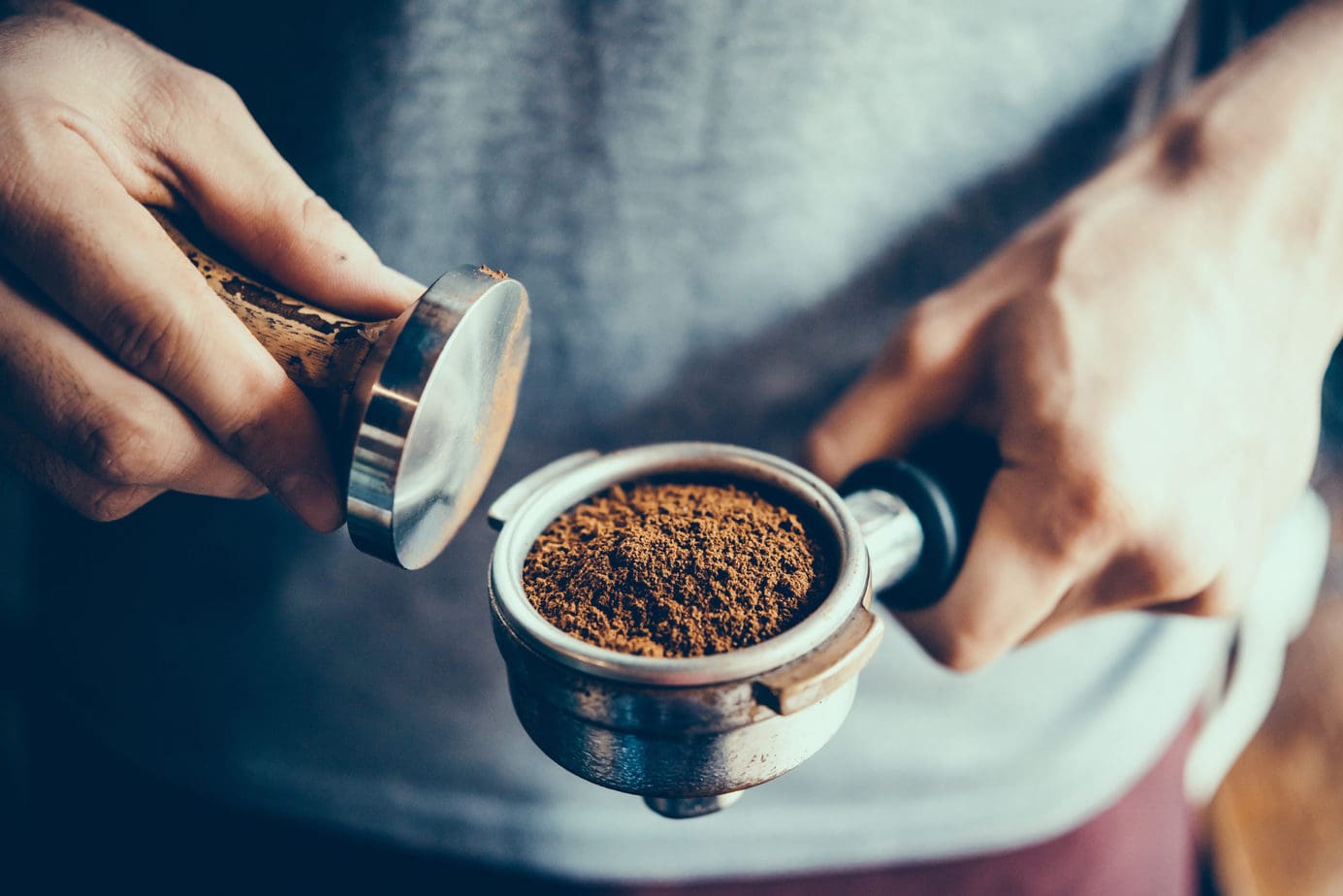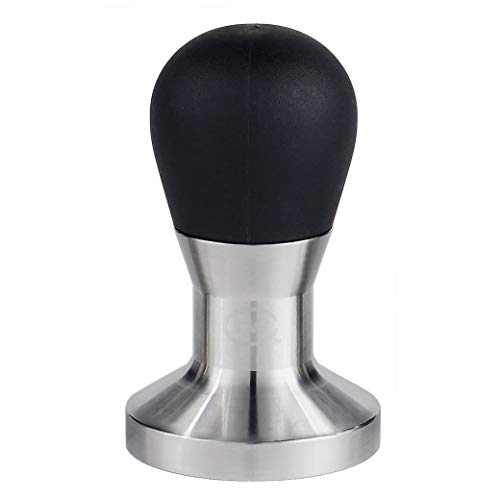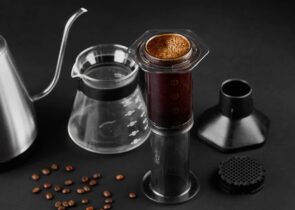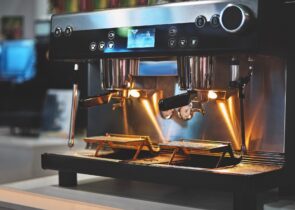When it comes to creating great espresso, every barista needs a great tamper. Whether you’re a casual coffee maker at home or beginning to open your own coffee shop, a good tamper is essential to the quality of the espresso that you’ll make.
At A Glance: Our Top 6 Picks for Espresso Tampers
But what is a tamper exactly? And why should I worry about which one I use?

Quick Summary: Best Espresso Tampers
| No products found. | Our Top Pick Espresso Parts Design - 5 Coffee Tamper with 58mm Flat Base |
| Check on Amazon → |
 | LuxHaus 49mm Calibrated Espresso Tamper |
| Check on Amazon → |
 | Rattleware 58mm Round-Handled Tamper, Long |
| Check on Amazon → |
 | Purple Mountain Tamper For Espresso Coffee-Flat Base |
| Check on Amazon → |
 | Benicci Espresso Coffee Tamper |
| Check on Amazon → |
 | Motta Professional Coffee Tamper, Flat Base 58mm |
| Check on Amazon → |
Stop…Tamper Time
Before we begin deciding what the best tamper is, we need to get a little refresher on this simple and spiffy tool, and the different characteristics we need to consider when purchasing one.
What is a tamper?
Tampers are smallish tools that play a big role in how your favorite cup of coffee is made. Fitting in the size of your hand, they are simple in design and also simple to use.
What do they do?
The reason why tampers are the most important players in the coffee game is that they compress ground espresso beans. After you order your cup of coffee, your barista will use the portafilter from their espresso machine and fill it with finely-ground espresso (so fine it’s almost like a light, powdery substance).
But in order to insert the espresso in their espresso machine, they will need to push it down or compact it into the portafilter before placing it back in the machine to pull the espresso shot. This is where a handy-dandy tamper comes in.
Tampers are important for three primary reasons:
- Tampers are needed to compact the coffee grounds in a portafilter because the more compact the grounds are, the more difficult it is for hot water to pass through the grounds. As the water fights to get through the coffee, it better captures the flavor of the coffee, creating crema and making higher-quality espresso overall.
- A good tamper is also essential because by pressing the coffee grounds together, is also pushes the grounds together to form a flat surface. This prevents uneven channels of water developing as it filters through the grounds, and ensures that the hot water saturates all of the grounds as a whole.
- Finally, as the tamper creates an even surface for the grounds, it also provides some room for the water to fill in the portafilter above the grounds, allowing it to soak the grounds more efficiently.
Top Picks for the Best Espresso Tamper
Espresso Parts Design – 5 Coffee Tamper with 58mm Flat Base
No products found.
When professional baristas reach for an espresso tamper, they often reach for the line up by Espresso Parts.
They offer a wide variety of options so you can always find one that fits your setup. This tamper ensures a consistent tamp pressure for every espresso shot made.
Overall, this tamper is a big favorite of ours as it offers a variety of different customizable features, making it an efficient choice for any barista.
LuxHaus 49mm Calibrated Espresso Tamper
Like the Espro, the LuxHaus Calibrated Espresso Tamper comes in a variety of diameter sizes as well. These other sizes include 51mm, 53mm, and 58mm.
Efficient and affordable, the LuxHaus is an ideal training tool for new baristas who are looking to gain better consistency with their tamps. Able to handle 30lbs of pressure when tamping, the LuxHaus is strong enough to get the job done every time.
Made of food-safe stainless steel, this tamper will not only guarantee a good espresso shot but will prevent any harmful chemicals or plating from other metal materials from contaminating your coffee.
Things that could be better: this tamper only comes with a flat face, which works well for those who prefer a perfectly level tamp, but for those who prefer a convex style, this tamper may not be the best fit.
Rattleware 58mm Round-Handled Tamper, Long
Weighing in at 1lb, the Rattleware Round-Handled Tamper is one of the most dependable non-calibrated tampers in the market. It has other sizes like 53mm and 57mm.
The base is made of stainless steel with a durable and impact-resistant handle made of ABS plastic. Its flat base makes for an even and consistent tamp every time, and the solid 1lb weight aids in adding a substantial amount of pressure during tamping. The size and shape of the handle also make this tamper easier for baristas with smaller hands to operate.
The downside to this tamper is that it doesn’t come in smaller sizes than 53mm and only comes with a flat-faced base. However, for the barista looking for simple-and-easy tamping while still compacting coffee grounds as tight as possible, this tamper fits the bill.
Purple Mountain Tamper For Espresso Coffee-Flat Base
Made completely of stainless steel, the Purple Mountain Tamper is a strong choice for those looking for as sturdy a tamper as possible. It weighs an impressive 1.5lbs, making a solid, compact tamp, while still light enough to prevent any strain or overuse for the barista.
This stainless steel has no extra plating that may flake off or affect the taste of espresso and is dishwasher safe. Due to its reliable material, the Purple Mountain Tamper is guaranteed to create clean and consistent tamps and also last you for a long time.
Not only does the tamper have an impressive weight, but it also has a decent amount of size options as well. As far as the diameter is concerned, the Purple Mountain is available in 49mm, 51mm, 53mm, and 58m.
Benicci Espresso Coffee Tamper
Another rather heavy tamper, the Benicci Tamper has about 1.4lbs of premium solid food-grade stainless steel. One of the best convex tampers on the market, the Benicci has an American convex curve (about 1.5mm) with a diameter of 58mm.
This smooth and clean, this tamper is simple and sleek in design but extremely affordable. As far as convex tampers go, this one is durable for those new to the coffee community and those who are already experts in espresso too.
One thing that could be better is that, though the material is sleek, solid, and strong, it is also scratchable. In order to keep the face in tip-top shape, its best to make sure that you take preventative measures to prevent any scratching or scuffing that may occur.
Motta Professional Coffee Tamper, Flat Base 58mm
Known for their elegant design, this Motta tamper has a natural ash wood handle accompanied by a 58mm flat-faced stainless steel base. About .77lbs, the Motta is extremely lightweight, but the heavy base still allows for a compact, well-pressured tamp.
Unfortunately, the primary downside to the Motta tamper is that it’s not dishwasher safe. For the barista looking for a snazzy tamper to use for the occasional espresso pour at home, the Motta will suffice nicely. Those shopping for a tamper that is able to be dish-washed or submerged in water regularly, a tamper made of steel might be a better choice.
Important Tamper Traits
Now that we know what they are and why they’re important, we can now begin to explore the different characteristics of this terrific tool. When considering which tamper works best for you, here are the most important qualities to consider:
Diameter
For tampers, size DOES matter. Every espresso machine has a portafilter. However, not all portafilters are the same. Most commercial espresso machines will have portafilters that require tamper sizes of 58mm, but there are also some that may be a bit smaller than this too.
Some of of the other sizes out there include 49mm, 51mm, 53mm, and 57mm. You want to make sure that the diameter of your tamper matches the diameter of your portafilter to ensure an all-around even tamp. The closer in size, the more even the tamp.
Weight
When tamping, there is a certain amount of force that is required to ensure that the grounds are compacted tight enough before water filters through them.
It’s crucial to make sure you’re tamper is not too light (as this would require you to push harder when tamping–increasing the risk of overstraining or hurting your hand/wrist), but not too heavy either (because that’s just plain exhausting).
Material
What’s inside the base of the tamper also plays a role in the taste/quality of the espresso. Plastic tampers are known for their convenience, especially for the more casual barista, and should do just fine for more relaxed brewing.
However, plastic is of lower quality and has the risk of causing uneven tamps due to the less dense material. It also has a higher risk of causing an uneven tamp due to the tamper base being uneven itself.
This is why more experienced baristas lean towards tampers that are made out of stronger, sturdier material, such as stainless steel or metal-based tampers. Not only will you have a better tamp overall, but they will also last longer and give you more bang for your buck.
The Handle
Just as the base of the tamper is important, the handle of the tamper is important as well. Since this is the part that you’ll be grabbing, holding, and handling (hehe), it’s important to consider the feel, material, and movement of a tamper’s handle. When it comes to handles, there are two main styles: calibrated or not calibrated, which we’ll explain a little later.
We’re “All About That Base”
Here’s where tampers continue to get more unique. Not only do tampers come in different sizes and designs, but they also come in several different base options. Different bases have a different influence on how an espresso shot may be pulled, and different baristas prefer different bases.
In this buying guide, we’ve included flat and convex tampers due to their overall functionality and efficiency.
Flat
Flat-faced tampers have a base with a face that is completely leveled. This ensures that when you tamp your grounds, the entire face of the tamper comes into contact with the coffee grounds, making the surface of the coffee as flat as possible.
Convex
For those who don’t prefer the flatness of the flat-base tampers, convex provides a bit of depth when tamping. Convex bases have a slight curve to them, so the face of the base is not completely flat.
The main reason some prefer this style of the tamper is its ability to help compact the outside edges of the espresso grounds in the portafilter. This further prevents the channeling of water around the inner walls of the portafilter and creates a surface that’s a little bit thinner in the center.
This is beneficial because it creates better suction between the portafilter and the coffee grounds, but can be a disadvantage if the density of the coffee is too uneven because the center of the grounds can be more compacted than the edges.
C-Flat
Lesser in popularity, the C-Flat shape is a hybrid between the flat and the convex shape. The edges of the face are slightly curved to better compact the edges of the grounds to the inner walls of the portafilter. The flat middle part of the face keeps the center compacted more evenly than just a normal convex base.
Rippled
Ripple-faced tampers are called so due to their ability to create ripples along the surface of the grounds. Tends to create uniform channeling of water throughout coffee grounds to promote even water distribution and saturation. This comes in handy because it prevents any grounds from “climbing” up the inner sides of the portafilter.
It’s perfect for the barista looking to add some flair to their brewing method but really serves no special purpose. This style can also be hard to clean because of the small grooves.
Though it does create a pretty design, this style is rarely used in the coffee industry. It’s mainly just for visual appeal and doesn’t really alter the quality or taste of the espresso.
Calibrated vs Non-Calibrated Tampers
When it comes to tampers, it’s not all about that base. The handles need some love, too! Thankfully, there are two convenient types of handles to accomplish this goal.
Calibrated Tampers
Some tampers are designed where the base of the tamper and the actual handle itself are disconnected. This is useful because it requires a certain amount of force to connect the base and the handle when tamping.
Most tampers that do this require about 30lbs of pressure, which is considered to be the “sweet spot” for tamping. Calibrating tampers are the perfect training tools for new baristas or for those wishing to increase their consistency when tamping.
Not-Calibrated Tampers
These tampers are simpler in design because the base and the handle are physically connected. Non-calibrated handles are common for more experienced baristas.
A Quick Tamper How-To
For those who are new to the art of tamping, it’s nice to get a few tips on the best way to hold and press your tamper when prepping to pull your espresso shot.
- Step One. Place the tamper inside of the portafilter, holding the handle with your thumb, index finger, and middle finger for support (similar to the way you’d hold a door handle if you were trying to open it).
- Step Two. Bend your arm at a 90-degree angle, your forearm directly vertical to the tamper. Once in this position, push down with enough force to feel a little resistance in the tamper, and then twist it to further flatten the grounds.
We’ve also attached a quick video tutorial if you need a visual demonstration of this as well. Click on the link to check it out!
The Top Tamping Tips:
The Force is Strong (But Not Too Strong)
We want our espresso to be compact enough to work with, so we need to make sure we’re applying the correct amount of force. There are several ways to do this.
One is placing the tamper on a smooth, even surface, like a countertop or a sturdy table, and pushing down on it as if you were creating an actual espresso shot. No matter how hard you push, you’ll soon realize that whatever surface you’re using, the surface itself is not moving or going anywhere (or, at least we hope not).
You might feel a little silly while doing this, but what you’ll also feel is a certain resistance from the surface. The harder you push, the more resistance you’ll feel.
Ultimately, when you tamper your espresso, you want to feel a good amount of resistance (some experts say around 20lbs, 25lbs, or 30lbs is ideal). However, don’t strain yourself too hard. If you feel like the amount of force you’re using is difficult to do repetitively or you begin to experience any strain, you’re probably applying too much force. (If it feels like you’re trying too hard—you’re doing it harder than you need to).
The Two “Deadly” Tamping Sins
There are two fatal errors to commit while tamping espresso: not placing it in the portafilter correctly, and not using consistent force.
The tamper must be level at all times. Don’t just stick the edge of the tamper in there first and “roll” the tamper into it to tamp it down. Make sure when you enter the tamper into the portafilter to compress the espresso, push it down with the tamper head being as flat and parallel to the espresso as possible. This creates an even surface for the water to filter through.
Force is important, but what’s more important is a consistent force. It doesn’t matter how much force you use, if you push too hard on one side of the tamper and too loosely on the other side, the water will still pour through it incorrectly and the shot will have to be redone.
This is why it’s best to tamp with your arm at a 90-degree angle, to ensure than an equal amount of force is applied throughout the entire area of the tamper’s face.
Wrapping Up
Ultimately, the best tamper is going to be the one that feels right and still gets the job done. It should be well made, dependable, affordable, and fit any other needs you may have.
When looking for a tamper, it’s best to keep in mind the diameter size, material, weight, base style, and calibration. Finding the combination of these traits will give you a tamper that gets the job done every single time.
Happy caffeinating!












